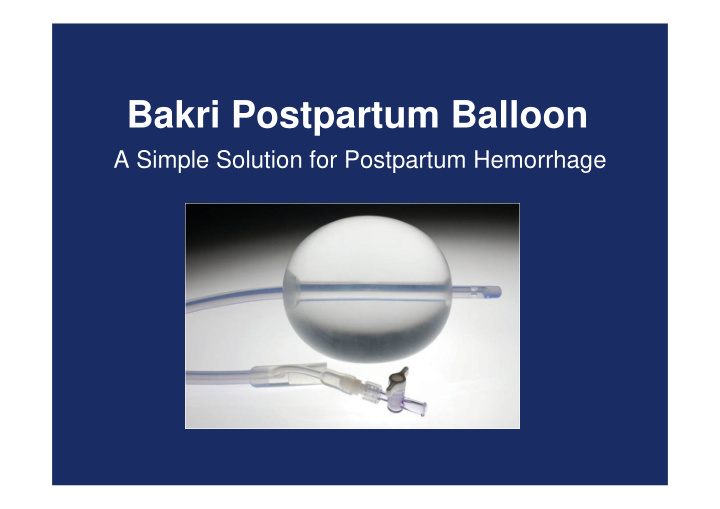



Bakri Postpartum Balloon A Simple Solution for Postpartum Hemorrhage
Bakri Postpartum Balloon Use of this device is intended to provide temporary control or reduction of postpartum uterine bleeding when conservative management is warranted.
Bakri Postpartum Balloon • Time-saving; easy to place and monitor. • Simplifies control of bleeding, potentially avoiding a hysterectomy. • Rapidly achieves tamponade within uterine cavity. • 100% Silicone.
Bakri Postpartum Balloon Maximum inflation is 500 ml 54 cm 24 Fr
Bakri Postpartum Balloon • May be used after vaginal or cesarean deliveries. • Should not be left indwelling for more than 24 hours. • Patient monitoring is very important.
Transvaginal Placement • Determine uterine volume by direct vision or ultrasound examination. • Using ultrasound guidance insert the balloon portion of the catheter in the uterus making certain that the entire balloon is inserted past the cervical canal and internal ostium.
Transvaginal Placement Caution: Avoid excessive force when inserting the balloon into the uterus. Place an indwelling urinary bladder Foley catheter at this time, if not already in place to collect and monitor urine output.
Transabdominal Placement, Post-Cesarean Section • Determine uterine volume by direct examination or ultrasound examination. • From above via access of the Cesarean incision, pass the tamponade balloon, inflation port first down through the uterus and cervix. – This will leave the balloon itself in the uterus and may limit the transmission of vaginal flora up and into the peritoneal cavity.
Transabdominal Placement, Post-Cesarean Section • Have an assistant pull the shaft of the balloon through the vaginal canal until the deflated balloon comes in contact with the internal cervical ostium. • Close the incision per normal procedure; avoid puncturing the balloon while suturing. Once the incision is closed you may inflate the balloon.
Balloon Inflation • Place an indwelling urinary bladder Foley catheter at this time, if not already in place, to collect and monitor urine output. • Using the enclosed 60 cc syringe, begin filling the balloon up to the predetermined volume through the stopcock.
Balloon Inflation Warning: Always inflate the balloon with sterile liquid. Never inflate with air, carbon dioxide or any other gas. Due to the compressibility of air, fluids are always safer. Warning: Do not overinflate the balloon. 500 cc is the maximum inflation volume.
Balloon Inflation Important: To ensure that the balloon is filled to the desired volume, it is recommended that the predetermined volume of fluid be placed in a separate container, rather than relying on a syringe count to verify the amount of fluid that has been instilled into the balloon.
Balloon Inflation Note: To maximize the tamponade effect, counter pressure can be applied by packing the vaginal canal with iodine or antibiotic soaked vaginal gauze.
Balloon Inflation Apply gentle traction to the balloon shaft to ensure proper contact between the balloon and tissue surface. To maintain tension, secure the balloon shaft to the patient’s leg or attach a weight, not to exceed 500 grams.
Balloon Inflation Connect the drainage port to a fluid collection bag to monitor hemostasis. Important: To adequately monitor hemostasis, the balloon drainage port should be flushed clear of clots with sterile isotonic saline.
Patient Monitoring Monitor patient continuously for signs of increased bleeding and uterine cramping. Warning: Patient monitoring is an integral part of managing postpartum hemorrhage. Signs of deteriorating or non-improving condition should lead to a more aggressive treatment and management of patient uterine bleeding.
Bakri – FAQ When should we not use the balloon? • Arterial bleeding requiring exploration or angiographic embolization. • Cases indicating hysterectomy. • Untreated uterine anomaly. • Cervical cancer. • Disseminated Intravascular Coagulation (DIC). Note: See the Instructions for Use for a complete list of contraindications
Clinical Data Warning: Clinical data to support the safety and effectiveness of the Bakri Postpartum Balloon in the setting of uterine atony are limited. Patients in whom this device is being used should be closely monitored for signs of worsening bleeding and/or disseminated intravascular coagulation (DIC). In such cases, emergency intervention per hospital protocol should be followed. Warning: There are no clinical data to support use of this device in the setting of DIC.
Bakri Postpartum Balloon A simple yet effective tool to conservatively treat postpartum hemorrhage.
References Bakri YN, Amri A, Abdul Jabbar F. Tamponade-balloon for obstetrical bleeding. Int J of Gynaecol and Obstet. 2001; 74:139-142. Condous GS, Arulkumaran S, Symonds I, Chapman R, Sinha A, Razvi K. The “tamponade test” in the management of massive postpartum hemorrhage. Obstet & Gynaecol. 2003; 101:767-772. Lalonde A, Daviss BA, Acosta A, Herschderfer K. Postpartum hemorrhage today. ICM/FIGO initiative 2004-2006. Int J Gynaecol Obstet. 2006; 94:243-253 American College of Obstetricians and Gyancologists. ACOG Practice Bulletin No. 76. Postpartum hemorrhage. American College of Obstetricians and Gynecologists. Obstet Gynecol 2006; 108:1039- 1047
Recommend
More recommend